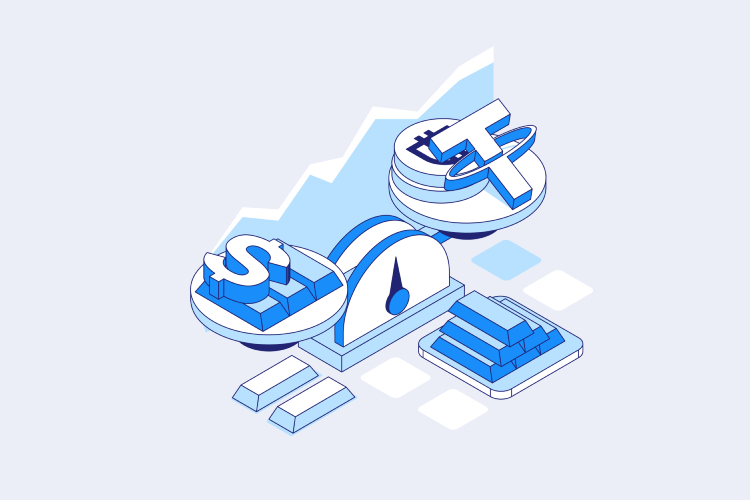This stability makes stablecoins different from cryptocurrencies like Bitcoin and Ethereum, which have prices that can fluctuate – sometimes dramatically. That unpredictability can make them difficult to use as people generally want to know how much their money will be worth a week or a month down the road.
It also puts cryptocurrencies like Bitcoin in stark contrast to the generally steady prices of fiat currencies like the U.S. dollar, or investments like gold. While the value of currencies like the dollar can fluctuate over time, daily fluctuations are usually more extreme for cryptocurrencies that rise and fall in value on a regular basis.
One of the key benefits of stablecoins is that they are more useful as a medium of exchange. Between 2020 and 2021, the market for stablecoins exploded, with market value increasing by three times.
Table of Contents

Why were stablecoins created?
Like any emerging asset class, cryptocurrencies are vulnerable to the forces of the market. Volatility can be a good thing for traders, but it makes routine transactions risky for both the buyer and the seller.
If a currency is going to be a medium of exchange, it has to stay relatively stable so people accepting it will feel confident that its purchasing power will remain in the short term. Traditional fiat currencies rarely see daily moves of even one per cent in forex trading.This issue has prompted many cryptocurrency projects to explore ways of minimizing risks and improving overall participation.
Stablecoins go beyond the traditional buy and sell orders that are typical in markets. Instead price stability is integrated into the asset. Stablecoins are intended to work as they sound – they are stable.

What are the main types of stablecoins?
There are four main types of stablecoins, based on their underlying collateral structure:
- Fiat-backed: Fiat is the most commonly used collateral for stablecoins. While the U.S. dollar is the most well-known fiat currency, companies are looking into stablecoins tied to other fiat currencies such as BiLira, which is tied to the Turkish Lira
- Commodity-backed: Some stablecoins are linked to the value of commodities such as silver or gold
- Cryptocurrency-backed: Some stablecoins use other cryptocurrencies like Ethereum to secure collateral
- Algorithmic: These stablecoins don’t use fiat currency or cryptocurrency as collateral, the value is kept stable by controlling supply using an algorithm. A stablecoin algorithmic system reduces the number of tokens available when the price of the market falls below the value of fiat currencies it is tracking. If the value of the coin is greater than the value of the currency, new coins come into circulation, adjusting the value of the stablecoin downward
What risks are associated with stablecoins?
Stablecoins may appear low-risk, especially when compared to other popular cryptocurrencies. However, they carry some of the same risks as other cryptocurrencies and vulnerabilities of their own.
- Security: Like any cryptocurrency, stablecoins have to be stored somewhere. That could be it in your personal wallet or through an exchange or broker. That presents risk if the trading platform isn’t secure
- Counterparty risk: Cryptocurrency has a reputation for being decentralized, but you’re dealing with multiple parties during transactions, including the bank that holds the reserves and the company that issues the stablecoin. Those parties need to follow the right steps in terms of security and properly reserving, to ensure the currency holds its value
- Reserve risk: The reserves backing the stablecoin are critical, without them the coin issuer can’t ensure the stability of a stablecoin’s value
- Confidence: A stablecoin that is not adequately supported by hard assets like cash, could face a crash and lose the peg to its primary currency. That was the case with TerraUSD in May 2022. The algorithmic stablecoin was supported by cryptocurrency as opposed to cash and its value plummeted as traders lost faith in its ability to hold the peg
What are the drawbacks of stablecoins?
The unique way that stablecoins are set up means they also have some unique drawbacks.
For example, if the funds are held by a bank or other third party, that introduces counterparty risk. Does the company really have the collateral that it claims to possess? This question is frequently raised with regards to Tether – does it have a true 1-1 backing between the USDT tokens and U.S. dollars?
If the reserves supporting the stablecoin aren’t enough to cover the cost of every unit, that could end up shaking confidence in the coin.
Cryptocurrencies were created to replace intermediary firms which are usually responsible for the user’s funds. By nature, intermediaries hold the power to control money. For instance, they are generally able to prevent transactions from taking place. Certain stablecoins are able to prevent transactions too.
SD coin has a way to block illegal payments, while Circle – one of the companies that operates behind USDC – confirmed in July of 2020 that it had frozen $100,000 of stablecoin on the direction of police.
Conclusion
Stablecoins offer a way to bridge the gap between fiat currencies and cryptocurrencies. They are price-stable assets that behave like fiat in some ways, yet offer the flexibility of cryptocurrency. Stablecoins present a unique solution to the volatility of cryptocurrency, because price stability is built in. There are four main types of stablecoins, which are based on their underlying collateral: fiat-backed cryptocurrency-backed, commodity-backed, and algorithmic.






